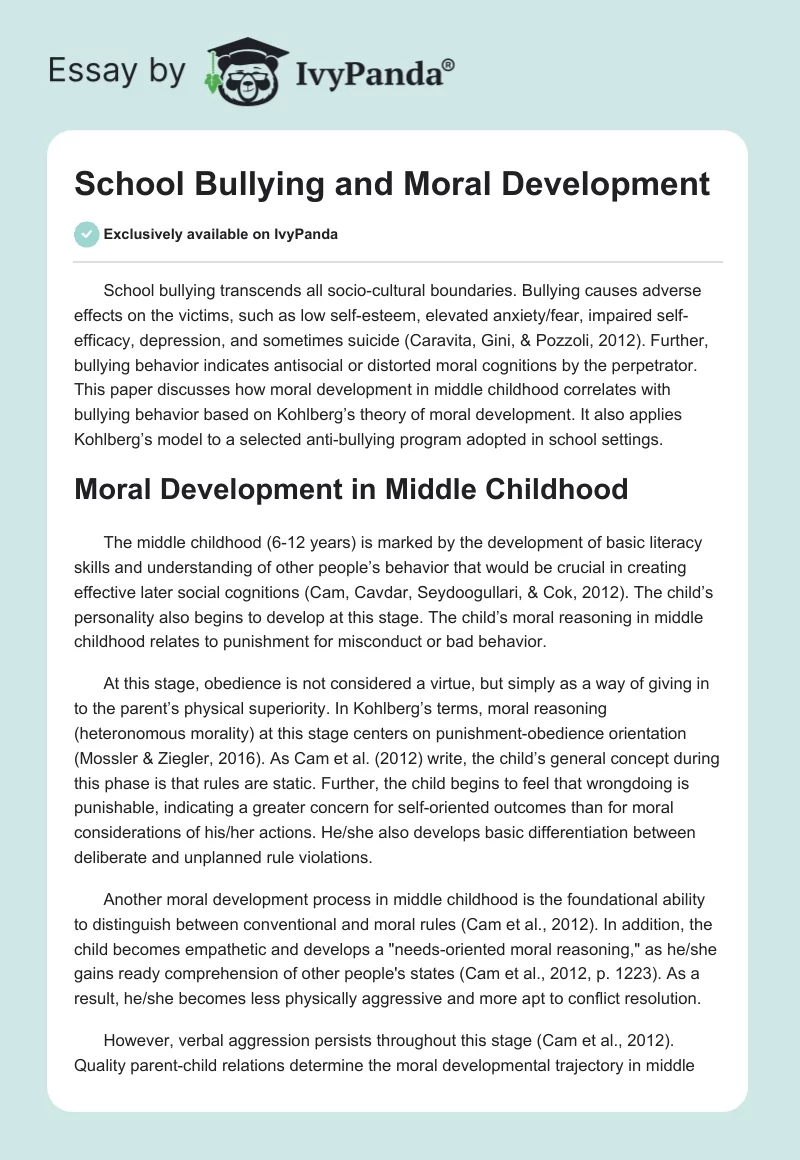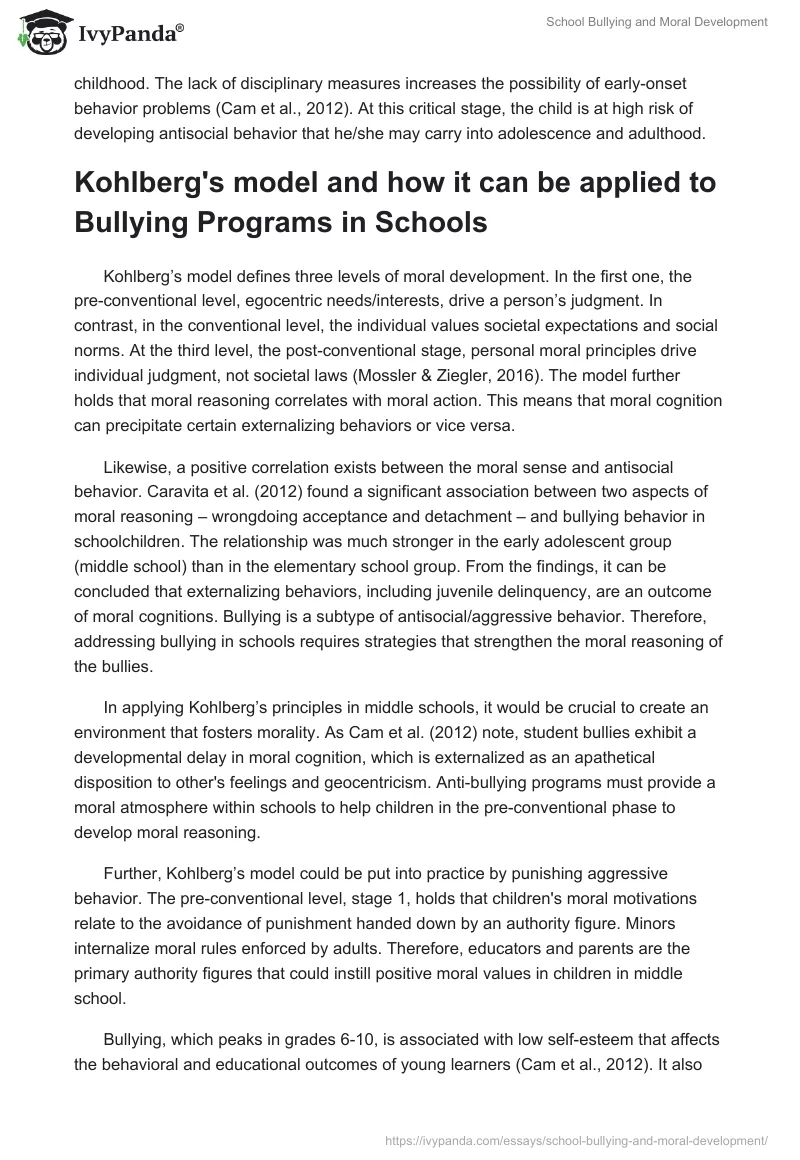School bullying transcends all socio-cultural boundaries. Bullying causes adverse effects on the victims, such as low self-esteem, elevated anxiety/fear, impaired self-efficacy, depression, and sometimes suicide (Caravita, Gini, & Pozzoli, 2012). Further, bullying behavior indicates antisocial or distorted moral cognitions by the perpetrator. This paper discusses how moral development in middle childhood correlates with bullying behavior based on Kohlberg’s theory of moral development. It also applies Kohlberg’s model to a selected anti-bullying program adopted in school settings.
Moral Development in Middle Childhood
The middle childhood (6-12 years) is marked by the development of basic literacy skills and understanding of other people’s behavior that would be crucial in creating effective later social cognitions (Cam, Cavdar, Seydoogullari, & Cok, 2012). The child’s personality also begins to develop at this stage. The child’s moral reasoning in middle childhood relates to punishment for misconduct or bad behavior.
At this stage, obedience is not considered a virtue, but simply as a way of giving in to the parent’s physical superiority. In Kohlberg’s terms, moral reasoning (heteronomous morality) at this stage centers on punishment-obedience orientation (Mossler & Ziegler, 2016). As Cam et al. (2012) write, the child’s general concept during this phase is that rules are static. Further, the child begins to feel that wrongdoing is punishable, indicating a greater concern for self-oriented outcomes than for moral considerations of his/her actions. He/she also develops basic differentiation between deliberate and unplanned rule violations.
Another moral development process in middle childhood is the foundational ability to distinguish between conventional and moral rules (Cam et al., 2012). In addition, the child becomes empathetic and develops a “needs-oriented moral reasoning,” as he/she gains ready comprehension of other people’s states (Cam et al., 2012, p. 1223). As a result, he/she becomes less physically aggressive and more apt to conflict resolution.
However, verbal aggression persists throughout this stage (Cam et al., 2012). Quality parent-child relations determine the moral developmental trajectory in middle childhood. The lack of disciplinary measures increases the possibility of early-onset behavior problems (Cam et al., 2012). At this critical stage, the child is at high risk of developing antisocial behavior that he/she may carry into adolescence and adulthood.
Kohlberg’s model and how it can be applied to Bullying Programs in Schools
Kohlberg’s model defines three levels of moral development. In the first one, the pre-conventional level, egocentric needs/interests, drive a person’s judgment. In contrast, in the conventional level, the individual values societal expectations and social norms. At the third level, the post-conventional stage, personal moral principles drive individual judgment, not societal laws (Mossler & Ziegler, 2016). The model further holds that moral reasoning correlates with moral action. This means that moral cognition can precipitate certain externalizing behaviors or vice versa.
Likewise, a positive correlation exists between the moral sense and antisocial behavior. Caravita et al. (2012) found a significant association between two aspects of moral reasoning – wrongdoing acceptance and detachment – and bullying behavior in schoolchildren. The relationship was much stronger in the early adolescent group (middle school) than in the elementary school group. From the findings, it can be concluded that externalizing behaviors, including juvenile delinquency, are an outcome of moral cognitions. Bullying is a subtype of antisocial/aggressive behavior. Therefore, addressing bullying in schools requires strategies that strengthen the moral reasoning of the bullies.
In applying Kohlberg’s principles in middle schools, it would be crucial to create an environment that fosters morality. As Cam et al. (2012) note, student bullies exhibit a developmental delay in moral cognition, which is externalized as an apathetical disposition to other’s feelings and geocentricism. Anti-bullying programs must provide a moral atmosphere within schools to help children in the pre-conventional phase to develop moral reasoning.
Further, Kohlberg’s model could be put into practice by punishing aggressive behavior. The pre-conventional level, stage 1, holds that children’s moral motivations relate to the avoidance of punishment handed down by an authority figure. Minors internalize moral rules enforced by adults. Therefore, educators and parents are the primary authority figures that could instill positive moral values in children in middle school.
Bullying, which peaks in grades 6-10, is associated with low self-esteem that affects the behavioral and educational outcomes of young learners (Cam et al., 2012). It also accounts for the high rate of absenteeism among students. In line with Kohlberg’s model, bullies are egocentric individuals, and thus, do not exhibit empathy for their victims. Anti-bullying programs should help bullies attain a high level of moral reasoning, where they show concern for other people’s feelings.
This can be achieved either through anti-bullying laws integrated into programs to foster the development of moral compassion among students or morality education. Moral knowledge would enable children to determine the morality of a transgression (Mossler & Ziegler, 2016). In this way, children will learn to attribute wrongdoing to the self, and thus, be motivated to avoid antisocial or bullying behavior.
Program Evaluation Using Kohlberg’s Model
KiVa is an anti-bullying program implemented nationally in Finnish schools since 2006. It is founded on the premise that positive peer bystander response is the key to curbing school bullying (KiVa International, n.d). Thus, KiVa aims at changing the peer context through victim support. It includes virtual learning environments, such as video games, to bolster group interaction and action in anti-bullying efforts. Educators and parents also receive resources and support to participate in universal anti-bullying activities.
The components of the KiVa program are consistent with the principles of Kohlberg’s model. Stage 3 of the model describes mutual interpersonal expectations as the motivations for moral reasoning. The child values shared feelings and expectations, which take precedence over individual needs (Mossler & Ziegler, 2016). The reasons for moral behavior relate to the desire to be a good person in social/peer environments. The KiVi program creates a moral environment to instill positive behavior and interaction as a way of reducing bullying in schools. It educates students about group dynamics, peer pressure, adverse effects of bullying, and anti-bullying strategies and support (KiVa International, n.d.).
Another component of the KiVa program related to Kohlberg’s moral development is showing concern for others. Level II, stage 3 of the model is defined by a caring disposition towards others. The KiVa program involves peers who support victimized/bullied children in schools. Another component of stage 3 of Kohlberg’s model is the desire for an authority figure that reinforces good behavior (Mossler & Ziegler, 2016).
The KiVa program involves adults – teachers and parents – in universal actions to support good morals and values. The KiVa team, led by the teacher, holds discussions with victims and their peers who are encouraged to support their friends. In addition, anti-bullying literature, branded vests, and posters are displayed in school environments to disparage bullying, while reinforcing stereotypical good behavior in the children.
Conclusion
Bullying has adverse effects on academic and behavioral outcomes of the victim. Kohlberg’s theory provides a framework for understanding the relationship between moral cognition and externalized anti-social or aggressive behavior in children. The evaluation of the KiVa anti-bullying program shows that adequate laws and peer support can reinforce good morality to help curb bullying in schools.
References
Cam, Z., Cavdar, D., Seydoogullari, S., & Cok, F. (2012). Classical and contemporary approaches for moral development. Educational Sciences: Theory & Practice, 12, 1222-1225. Web.
Caravita, S., Gini, G., & Pozzoli, T. (2012). Main and moderated effects of moral cognition and status on bullying and defending. Aggressive Behavior, 38, 456–468. Web.
KiVa International. (n.d.). Welcome to KiVa School. Web.
Mossler, R., & Ziegler, M. (2016). Understanding development: A lifespan perspective. San Diego, CA: Bridgepoint Education.



